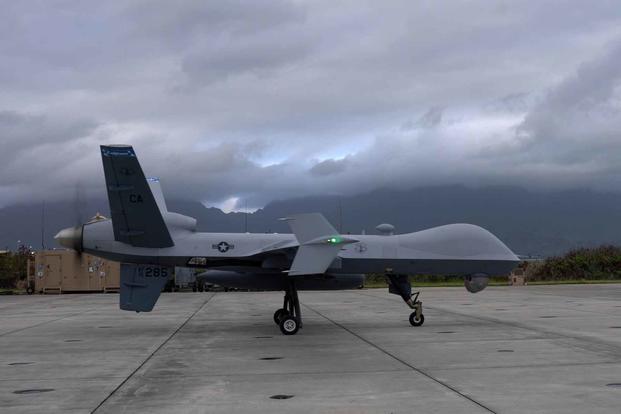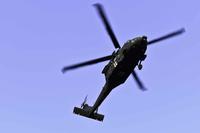Marines in Kaneohe are now officially cleared to operate their new drones as the service reorganizes its forces for Pacific operations.
"Marine Unmanned Aerial Vehicle Squadron 3 (VMU-3 ) safely and successfully tested and flew its first MQ-9A remotely piloted aircraft. The squadron is now certified to independently operate the MQ-9A, " a Marine Corps news release said.
The MQ-9A, better known as the Reaper, first flew out of Kaneohe in 2021 when the Air Force brought the system to Hawaii in a cross-Pacific flight to train in the islands. Marines participated in the exercise, familiarizing themselves in preparation for when they would receive their own.
The Reapers replace the RQ-21A Blackjack drones that the Marines previously operated. The stealthy Reapers have longer wingspans and are capable of flying much higher and for longer distances, and can be refueled in the air by fuel tanker planes that also recently arrived at the base.
The squadron received its first two Reapers in April, after which it worked to assemble and prepare the aircraft for the Naval Air Systems Command safety certification process. The Safe-for-Flight Operations Certification is the final step in the transition from Blackjacks to Reapers in Kaneohe.
The Marine Corps is in the midst of an ambitious makeover of its forces called Force Design 2030 as it looks to return to the Pacific. After two decades of hunting insurgents in Iraqi deserts and Afghan mountains after the Sept. 11, 2001, terror attacks, the service is looking to return to its naval roots with a focus on island and coastal operations amid tensions with China.
Force Design 2030 envisions Marines moving through island chains in the Pacific, setting up missile batteries to attack enemy ships and disrupt supply lines and using tools such as drones for surveillance.
The new strategy is geared in large part toward Western Pacific operations with a particular emphasis on the South China Sea, a critical waterway through which more than a third of all international trade travels. Beijing considers the entire waterway to be its exclusive sovereign territory, over the objections of neighboring countries. The Chinese military has built bases on disputed islands and reefs and even built artificial islands to assert its claims.
Earlier this year during an exercise in the Philippines, troops from the 3rd Marine Littoral Regiment out of Kaneohe and the Army's Schofield Barracks-based 25th Infantry Division joined members of the Philippine Marine Corps in an island-hopping exercise in the Luzon Strait taking them just south of Taiwan.
Escalating tensions between China and self-ruled Taiwan, which Beijing considers a rogue province and has vowed to bring under its control by military force if it deems necessary, have raised concerns of the potential for a large-scale conflict in the Pacific. The establishment of blockades or the breakout of war in the South China Sea or the Taiwan Strait could shut off some of the world's busiest shipping lanes and upend the global economy.
Regional leaders have urged talks between the United States and China to ease hostilities, though senior Chinese military leaders have refused to speak with their American counterparts. U.S. Secretary of State Antony Blinken met with Chinese President Xi Jinping on June 19 in an effort to stabilize fraying relations between the United States and China, but tensions remain high.
Even as the Marines look to shift gears from the drawn-out wars in Iraq and Afghanistan to focus on the Pacific, for much of the American public, drones became an iconic weapon inextricably tied to the U.S. war on terror. Drones became a central tool in secretive military and CIA counterterrorism operations where they were used extensively for surveillance and targeted killings in countries across the Middle East and Africa.
But the precision of those operations has been hotly debated. During the chaotic 2021 evacuation of civilians from Kabul, Afghanistan, a Reaper struck what the military initially said was a bombmaker after ISIS militants killed 13 U.S. service members and more than 150 Afghan civilians in a bombing at Hamid Karzai International Airport. The Pentagon later admitted the strike actually killed 10 civilians—including seven children—and no militants.
The Reapers' arrival in Hawaii hasn't been without controversy. During the 2021 drone exercise, local activists demonstrated outside the Marines' Kaneohe base with signs that read, "No Reapers !" and "Drones Kill Kids." One of them was Ann Wright, a retired Army officer and diplomat who became an outspoken critic of the U.S. military.
Wright told the Honolulu Star-Advertiser that "now Hawaii-based young men and women who operate killer drones will have the same long-term traumatic stress as operators from other U.S. drone bases who killed innocent civilians, as has been the history of drone operators who have killed wedding parties, funeral processions and kids meeting their parents in Afghanistan, Iraq, Yemen, Mali, Syria."
But while the MQ-9A was originally designed as a "hunter killer " drone with the ability to deploy Hellfire missiles, the Marine Corps says it doesn't intend to arm its new drones in Hawaii—at least for now.
During the 2021 drone exercise, the Marine Corps said in a statement that "our service envisions distributed teams of Marines that can hunt an adversary's ships visually or electronically using every sensor and capability available to them. Our current operational vision for the MQ-9 here in Hawaii does not call for arming Marine Corps MQ-9s at this time, but rather using them for surveillance and reconnaissance."
In its news release, the Marine Corps said the drone squadron at Kaneohe is expecting to do a "showcase " of its new Reapers later this summer.
___
(c)2023 The Honolulu Star-Advertiser
Visit The Honolulu Star-Advertiser at www.staradvertiser.com
Distributed by Tribune Content Agency, LLC.











